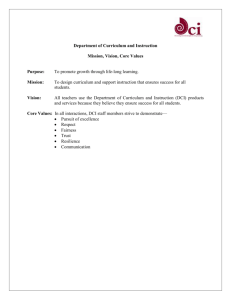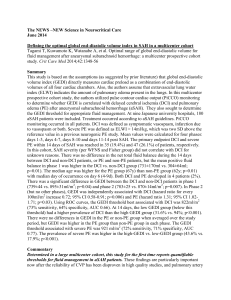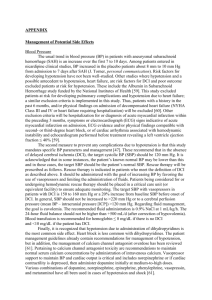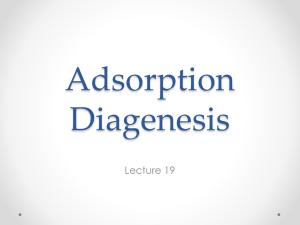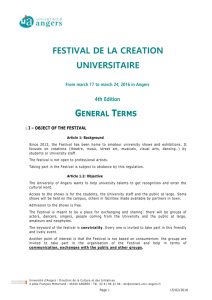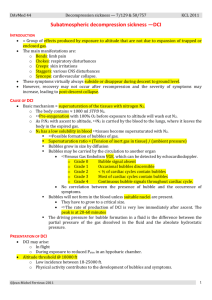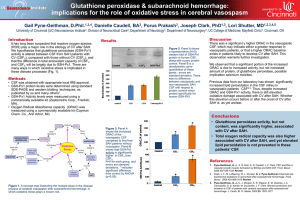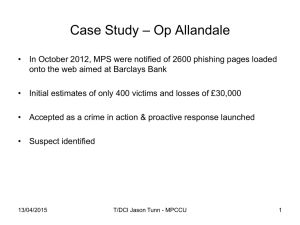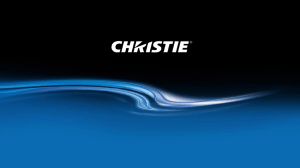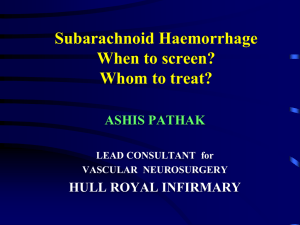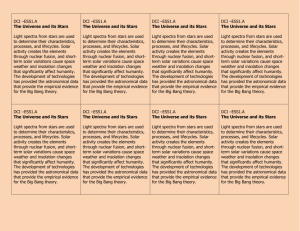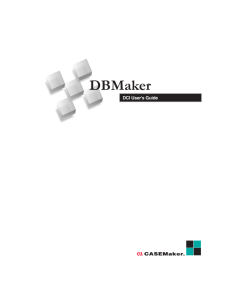Critical Care Management of Patients Following Aneurysmal
advertisement
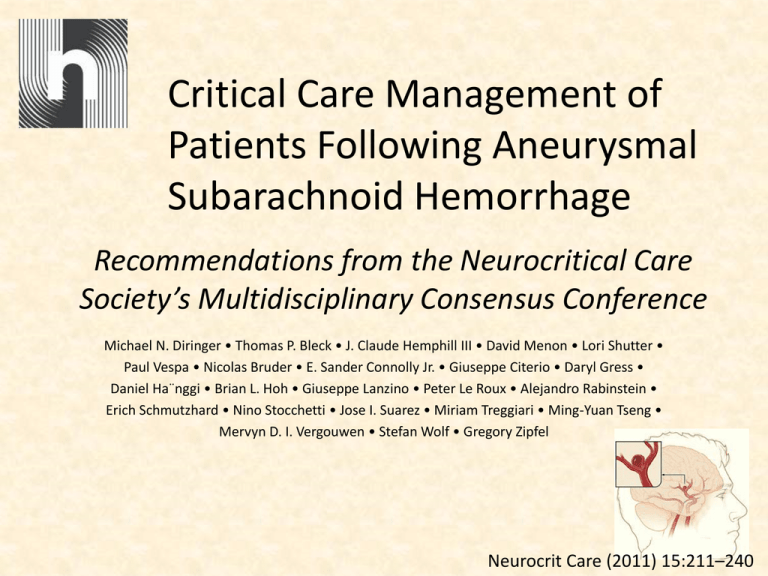
Critical Care Management of Patients Following Aneurysmal Subarachnoid Hemorrhage Recommendations from the Neurocritical Care Society’s Multidisciplinary Consensus Conference Michael N. Diringer • Thomas P. Bleck • J. Claude Hemphill III • David Menon • Lori Shutter • Paul Vespa • Nicolas Bruder • E. Sander Connolly Jr. • Giuseppe Citerio • Daryl Gress • Daniel Ha¨nggi • Brian L. Hoh • Giuseppe Lanzino • Peter Le Roux • Alejandro Rabinstein • Erich Schmutzhard • Nino Stocchetti • Jose I. Suarez • Miriam Treggiari • Ming-Yuan Tseng • Mervyn D. I. Vergouwen • Stefan Wolf • Gregory Zipfel Neurocrit Care (2011) 15:211–240 Purpose & Process • The purpose of the consensus conference was to develop recommendations for the critical care management of patients following acute aneurysmal SAH • Experts from Europe and North America from the fields of neurosurgery, neurocritical care, neurology, interventional neuroradiology, and neuroanesthesiology were recruited based on their expertise related to each topic Methods The GRADE System: • The quality of evidence was graded as • High = Further research is very unlikely to change confidence in the estimate of effect • Moderate= Further research is likely to have an important impact on confidence in the estimate of effect and may change the estimate • Low = Further research is very likely to have an important impact on confidence in the estimate of effect and is likely to change the estimate. • Very low = Any estimate of effect is very uncertain • Recommendations were classified as strong or weak • According to the balance among benefits, risks, burden, and cost, and according to the quality of evidence Medical Measures to Prevent Rebleeding Strong Recommendations High or Moderate Quality Evidence Low or Poor Quality Evidence Weak Recommendations •Early aneurysm repair •Avoid delayed or prolonged antifibrinolytic therapy •Antifibrinolytic therapy is relatively contraindicated in patients with risk factors for thromboembolic complications •Patients treated with antifibrinolytic therapy should have close screening for deep venous thrombosis •Treat extreme hypertension •Consider an early, short course of antifibrinolytic therapy •Antifibrinolytic therapy should be discontinued 2 hours before planned endovascular aneurysm ablation •CTA should be performed preferentially over DSA if endovascular intervention is not planned at the time of angiography Seizures and Prophylactic Anticonvulsant Use Strong Recommendations •Routine use of anticonvulsant prophylaxis with phenytoin is Low or not recommended Poor •Consider cEEG monitoring in patients with poor-grade SAH Quality Evidence who fail to improve or who have neurological deterioration of undetermined etiology Weak Recommendations •In patients who suffer a seizure after presentation, anticonvulsants should be continued for a duration defined by local practice •If anticonvulsant prophylaxis is used, a short course (3–7 days) is recommended •Routine use of other anticonvulsants for prophylaxis may be considered Cardiopulmonary Complications Strong Recommendations High or Moderate Quality Evidence •Target euvolemia in cases of pulmonary edema or acute lung injury •Standard management of heart failure is indicated, except CPP/MAP should be maintained Low or Poor Quality Evidence •Obtain baseline serial cardiac enzymes, EKG and ECHO •Monitoring cardiac output may be useful in patients with evidence of hemodynamic instability or myocardial dysfunction Monitoring Intravascular Volume Status Strong Recommendations •Central venous lines should not be placed solely to obtain CVP measures and fluid High or management should not be Moderat based on CVP measurements is e Quality not recommended Evidence •Routine use of pulmonary artery catheters is not recommended Weak Recommendations •Monitoring of volume status may be beneficial •Vigilant fluid balance management should be the foundation for monitoring intravascular volume status; no specific modality can be recommended over clinical assessment Managing Intravascular Volume Status Strong Recommendations High or Moderate Quality Evidence •Intravascular volume management should target euvolemia and avoid prophylactic hypervolemic therapy Weak Recommendations •Isotonic crystalloid is the preferred agent for volume replacement •In patients with a persistent negative fluid balance, use of fludrocortisone or hydrocortisone may be considered Glucose Management Strong Recommendations High or Moderat e Quality Evidence Low or Poor Quality Evidence Weak Recommendations •Hypoglycemia (serum glucose <80 mg/dl) should be avoided •Serum glucose should be maintained below 200 mg/dl •If microdialysis is being used, serum glucose may be adjusted to avoid low cerebral glucose Management of Pyrexia Strong Recommendations High or Moderate Quality Evidence Low or Poor Quality Evidence •Monitor temperature frequently; always seek and treat infectious causes of fever •Antipyretic agents should be used as first line therapy, even though efficacy is low •Surface cooling or intravascular devices should be employed when antipyretics fail in cases where fever control is highly desirable •Monitor and treat for shivering •During the period of risk for DCI control of fever is desirable; intensity should reflect the individual patient’s relative risk of ischemia Deep Venous Thrombosis Prophylaxis Strong Recommendations High or Moderate Quality Evidence •Measures to prevent DVT should be employed in all SAH patients •Sequential compression devices should be routinely used in all patients •Unfractionated heparin for prophylaxis could be started 24 h after undergoing surgery •Unfractionated heparin and low molecular weighted heparin should be withheld 24 h before and after intracranial procedures Low or Poor Quality Evidence •Low molecular weight heparin or unfractionated heparin for prophylaxis should be withheld in patients with unprotected aneurysms and expected to undergo surgery Weak Recommendations •The duration of DVT prophylaxis is presently uncertain but may be based on patient mobility Magnesium & Statins High or Moderate Quality Evidence Low or Poor Quality Evidence Strong Recommendations Weak Recommendations •Inducing hypermagnesemia is not recommended pending the conclusion of current randomized trials •Hypomagnesemia should be avoided •Acute statin therapy in statin-naive patients may be considered for reducing DCI following aneurysmal SAH, pending the outcome of ongoing trials •Patients on statins prior to presentation with aneurysmal SAH should have their medication continued in the acute phase Definitions: Delayed Neurological Deterioration, Delayed Cerebral Ischemia and Vasospasm Strong Recommendations High or Moderate Quality Evidence •SAH clinical trials should use only radiographic evidence of cerebral infarction and functional outcome as the primary outcome measures Monitoring for DCI and Triggers for Intervention Strong Recommendations High or Moderate Quality Evidence •Oral nimodipine (60 mg every 4 h) should be administered after SAH for a period of 21 days • Imaging of vascular anatomy and/or perfusion can be used to confirm a diagnosis of DCI in monitored good grade patients who show a change in neurologic exam or TCD variables •Monitoring for neurological deterioration, and specifically DCI, should take place in an environment with substantial multidisciplinary expertise in the management of SAH Low or Poor Quality Evidence •Patients at high risk for DCI should be closely monitored throughout the at risk period. This is best accomplished in an ICU setting where additional monitoring and treatment can be rapidly implemented. a) Monitoring for DCI Strong Recommendations High or Moderate Quality Evidence Low or Poor Quality Evidence Weak Recommendations •Employ a strategy for detection and confirmation of DCI, including frequent repeat neurological assessment by qualified providers •DSA is the gold standard for detection of large artery vasospasm •TCD may be used for monitoring and detection of large artery vasospasm with variable sensitivity. •High quality CTA can be used for screening for vasospasm, and may reduce the need for DSA •CTP findings or elevated MTT may be additive to CTA findings in predicting DCI •EEG, pbtO2 and CMD may all be useful for DCI detection; the relative value of these monitors individually vs. part of a multimodality monitoring strategy is not known b) and Triggers for Intervention Strong Recommendations High or Moderate Quality Evidence •In high risk patients who have a clinical picture strongly suggestive of DCI, and in whom elective screening CTA/CTP or DSA has already demonstrated vasospasm/DCI, it is reasonable to initiate medical therapy without further investigations •If there is clinical uncertainty regarding the cause of neurological deterioration, DSA is indicated if an endovascular intervention is planned Hemodynamic Management of DCI Blood Pressure Strong Recommendations High or Moderate Quality Evidence •Patients clinically suspected of DCI should undergo a trial of induced hypertension •Choice of vasopressor should be based on the other pharmacologic properties of the agents (e.g., inotropy, tachycardia) Low or Poor Quality Evidence •If nimodipine administration results in hypotension, then dosing intervals should be changed to more frequent lower doses. If hypotension continues to occur, then nimodipine may be discontinued •Blood pressure augmentation should progress in a stepwise fashion with assessment of neurologic function at each MAP level to determine if a higher blood pressure target is appropriate Hemodynamic Management of DCI Intravascular Volume and Inotropy Strong Recommendations Weak Recommendations High or Moderate Quality Evidence •The goal should be maintaining euvolemia, rather than attempting to induce hypervolemia •Inotropes with prominent b-2 agonist properties (e.g., dobutamine) may lower MAP and require increases in vasopressor dosage •Consider a saline bolus to increase CBF in areas of ischemia as a prelude to other interventions Low or Poor Quality Evidence •If patients with DCI do not improve with blood pressure augmentation, a trial of inotropic therapy may be considered •Mechanical augmentation of cardiac output and arterial blood flow (e.g., intra-aortic balloon counterpulsation) may be useful Hemodynamic Management of DCI Hemodilution and Unsecured Aneurysms Strong Recommendations High or Moderate Quality Evidence •Hemodilution in an attempt to improve rheology should not be undertaken except in cases of erythrocythemia •Unsecured aneurysms which are not thought to be responsible for the acute SAH should not influence hemodynamic management Low or Poor Quality Evidence •If the aneurysm thought to have ruptured is unsecured when a patient develops DCI, cautious blood pressure elevation to improve perfusion might be attempted, weighing potential risks and benefits Endovascular Management of DCI Strong Recommendations High or Moderate Quality Evidence •The use of routine prophylactic cerebral angioplasty is not recommended •Endovascular treatment using intra-arterial vasodilators and/or angioplasty may be considered for vasospasm related DCI •The timing and triggers of endovascular treatment of vasospasm remains unclear, but generally rescue therapy for ischemic symptoms that remain refractory to medical treatment should be considered Anemia and Transfusion Strong Recommendations High or Moderate Quality Evidence Low or Poor Quality Evidence •Patients should receive packed RBC transfusions to maintain hemoglobin concentration above 8–10 g/dl •Measures should be taken to minimize blood loss from blood drawing •Transfusion criteria for general medical patients should not be applied to decisions in SAH patients. •Higher hemoglobin concentrations may be appropriate for patients as risk for DCI, but whether transfusion is useful cannot be determined from the available data Endocrine Function & Management of Hyponatremia Strong Recommendations •Hydrocortisone or fludrocortisone may be used to limit natriuresis and hyponatremia •High dose corticosteroids are not recommended •Consider hypothalamic dysfunction should in patients unresponsive to vasopressors •Hormonal replacement with mineralocorticoids should be considered in to prevent hypovolemia and hyponatremia High or Moderate Quality Evidence Low or Poor Quality Evidence Weak Recommendations •Do not treat hyponatremia with fluid restriction •Use extreme caution to avoid hypovolemia if vasopressinreceptor antagonists are used •Mild hypertonic saline solutions can be used to treat hyponatremia •Limit free water intake via intravenous and enteral routes •Hormonal replacement with stress-dose corticosteroids for patients with vasospasm and unresponsiveness to induced hypertension may be considered High Volume Centers Strong Recommendations High or Moderate Quality Evidence •Patients with SAH should be treated at high volume centers •High volume centers should have appropriate specialty neurointensive care units, neurointensivists, vascular neurosurgeons and interventional neuroradiologists to provide the essential elements of care
